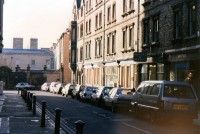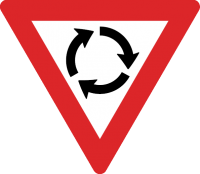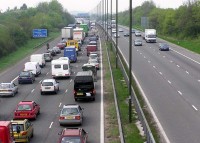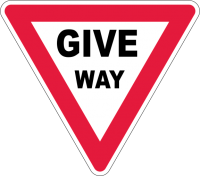Driving in the UK holds many challenges for an American tourist – starting with the fact that using the left half of the road instead of the right is far easier said than done. It can play havoc with your sense of positioning, especially if you rent a right- hand-drive vehicle, which will give you an entirely different perspective from what you are used to. You may well find yourself skimming dangerously close to the left extremity of your lane.
hand-drive vehicle, which will give you an entirely different perspective from what you are used to. You may well find yourself skimming dangerously close to the left extremity of your lane.
Driving on the left also means yielding to the left at intersections, overtaking on the right, finding right turns more complicated than left turns, and going clockwise around traffic roundabouts. Of course, this is all assuming that you get as far as mastering the gearstick with your left hand. Don’t try to use your feet the other way around, though – the accelerator pedal is still the one on the right.
 On top of all these complications, a lot of roadways in British towns are rather narrow. Many town centers were constructed before cars were widely owned – or even invented. Sometimes, that doesn’t only mean that the streets are very slender – it also means they have parked cars down both sides because the houses do not have garages. An experienced driver of UK town centers will be almost constantly weaving left and right, slowing and speeding up, to avoid hitting either parked cars or oncoming traffic. If it’s any consolation, British drivers sometimes find American roads intimidating to drive, as they are “too broad.”
On top of all these complications, a lot of roadways in British towns are rather narrow. Many town centers were constructed before cars were widely owned – or even invented. Sometimes, that doesn’t only mean that the streets are very slender – it also means they have parked cars down both sides because the houses do not have garages. An experienced driver of UK town centers will be almost constantly weaving left and right, slowing and speeding up, to avoid hitting either parked cars or oncoming traffic. If it’s any consolation, British drivers sometimes find American roads intimidating to drive, as they are “too broad.”
 Pedestrians are not as much of a persecuted minority in Britain as they are in America. Traffic light sequences are designed to avoid cars turning into streets at the same time that walkers have the all-clear to cross those streets. And motorists are not permitted to turn left – the British equivalent of right – on a red light. By the way, if someone talks about having a red or a green light, they are not necessarily talking about the signals for traffic. Pedestrians’ signals, too, are red and green.
Pedestrians are not as much of a persecuted minority in Britain as they are in America. Traffic light sequences are designed to avoid cars turning into streets at the same time that walkers have the all-clear to cross those streets. And motorists are not permitted to turn left – the British equivalent of right – on a red light. By the way, if someone talks about having a red or a green light, they are not necessarily talking about the signals for traffic. Pedestrians’ signals, too, are red and green.
If you step into a corner shop or a pub to ask directions, bear in mind that Brits are less likely than Americans to assume automatically that you are traveling by car. It’s worth clarifying that point before you get directed down a road that is reserved for pedestrians – not an uncommon thing in downtown areas.
 There are a few linguistic differences to deal with as well. A triangular sign that says “Give Way” is telling you the same thing as a US “Yield” sign. Freeways are called motorways – something that is reflected in these roads’ names, which consist of the letter M and a number. And if someone tells you that you are driving on the “pavement,” you have a problem, because this means the sidewalk.
There are a few linguistic differences to deal with as well. A triangular sign that says “Give Way” is telling you the same thing as a US “Yield” sign. Freeways are called motorways – something that is reflected in these roads’ names, which consist of the letter M and a number. And if someone tells you that you are driving on the “pavement,” you have a problem, because this means the sidewalk.
But at least there is one respect in which driving in Britain is less confusing, for an American, than driving in mainland Europe. At time of writing, Brits still differ from their European Union brethren by using what they call the “imperial” system of measurement. In plain English – they don’t use kilometers, but miles.


Comments